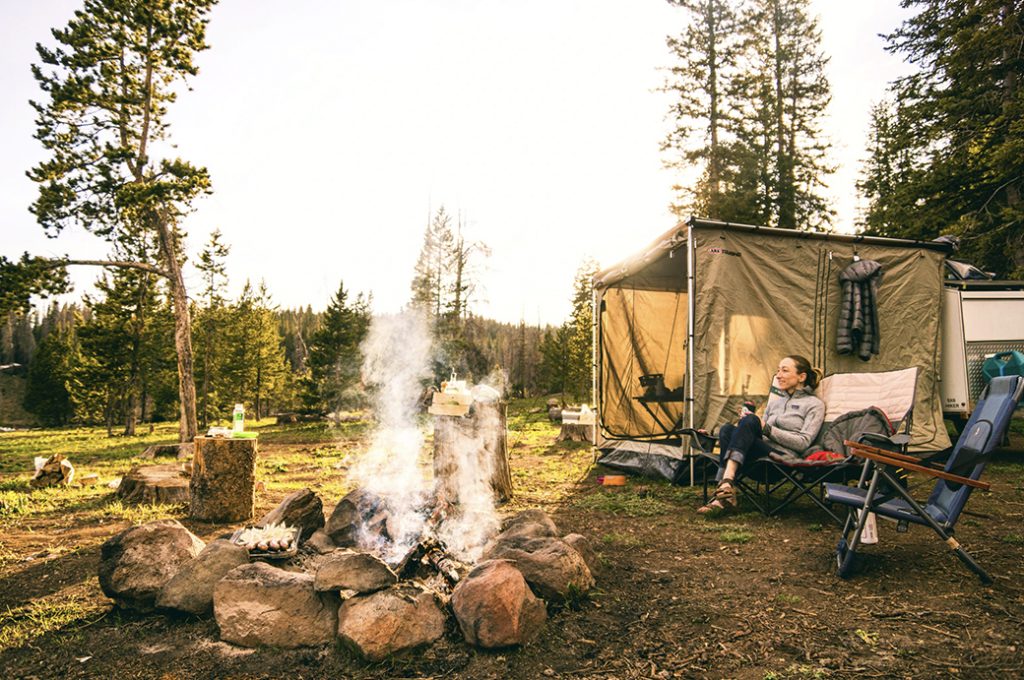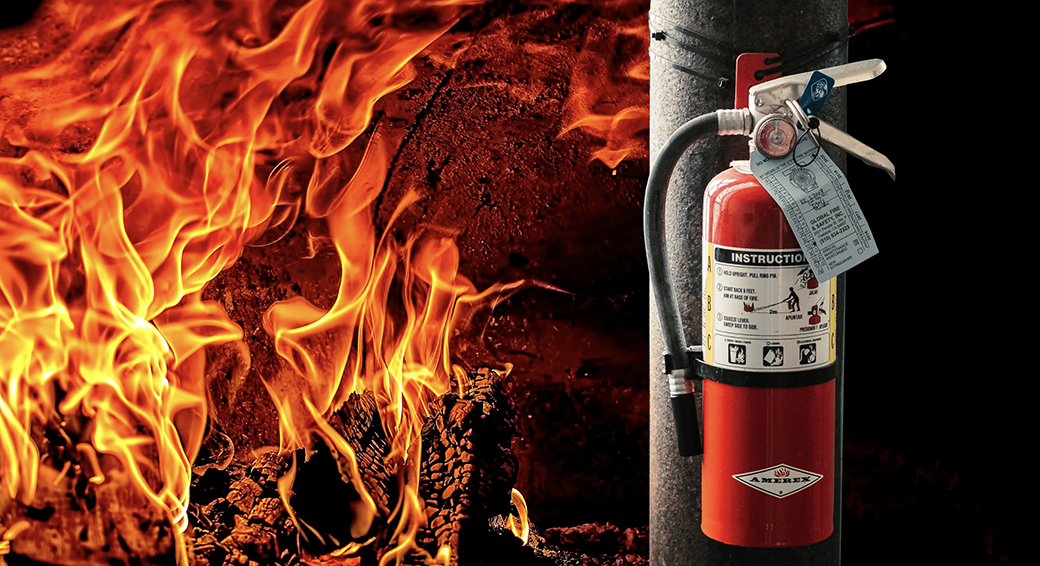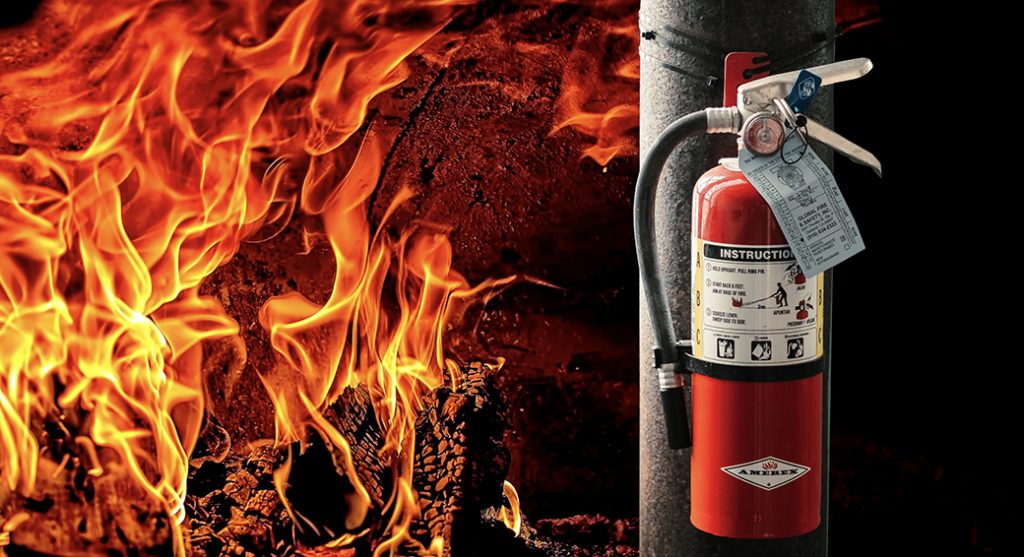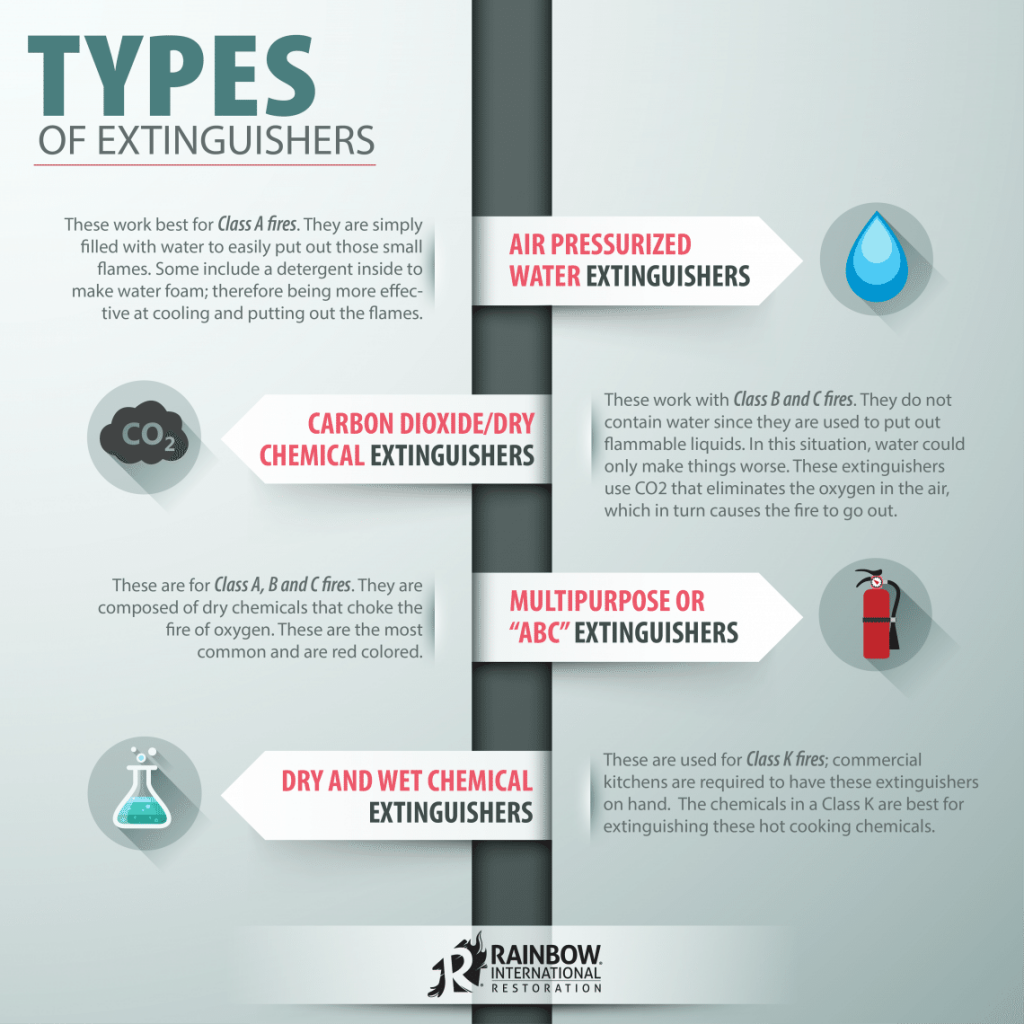On the heels of the Disaster in an RV series, it seems a good time to talk about fire.
Few will argue that a blazing campfire at the end of the day really makes it cozy and fun. But one place no one wants to deal with fire is INSIDE your rig. Regardless what size or type RV you live in, and for however long/often, fire is one element you want to stay far away from…at least the open, uncontrolled kind.

In that vein—since we’re heading into heating season for those who live in their campers and vans during cold weather, and since most of us will be doing more cooking inside—this post will cover
- basic fire safety
- choosing and using the correct fire extinguisher for your rig, and
- how and when to use it properly and effectively.
Basic RV Fire Safety
Fire safety basics are the same in an RV as they are anywhere else. The challenge in an RV is that combustible materials are almost always positioned closer to sources of ignition, and the time it takes fire to spread to the rest of your rig is way less than it would take to engulf a sticks-and-bricks house. That means your response reflexes must be even faster, if fire should break out. And that’s really saying something, since experts believe most folks have just two minutes to escape a burning building before their chances of getting out alive go way down.
Here are the Big Three things to do before fire ever strikes:
- Buy good quality smoke detectors and place one in each bedroom with a door, one outside each sleeping area, and one in your kitchen area. If you have a large rig such as a Class A or fifth wheel, you may also want to put one amidships or anywhere you have access to your basement, especially if you have lightbulbs down there to keep your water lines from freezing. Make sure all detectors are working before each trip, and refresh their batteries when you change the clocks for the beginning and end of Daylight Saving Time.
- Practice fire drills with everyone on board (the Red Cross’ provides these guidelines). Go over possible routes to get out of your rig fast, and make sure everyone knows the location of emergency exit windows and how to operate them. Issue everyone a small flashlight and insist it remain easily accessible near their bed, to be used for nothing else. Change batteries in them when you refresh those in your smoke alarms.
- Choose a meeting place outside that’s a safe distance from your rig, and let everyone know what it is. When you’re in a campground, the obvious choice would be the office. If you’re boondocking, it should be an easily identifiable landmark nearby. Planning all this ahead of time is quick and easy, and should be part of your setup routine every time you reach a new camp.
And of course, you should take steps to prevent RV fires from happening in the first place. Most of these suggestions are common sense, but they’re worth going over:
- Always keep matches and lighters out of the reach of children.
- Keep flammable items at least three feet away from anything hot, such as space heaters (especially propane ones with an open flame), ovens and fireplaces.
- Only smoke outside, and carefully extinguish all smoking materials before entering your RV.
- When you’re cooking, always stay in the kitchen or close by, in case something catches fire.
- Remember to shut off your oven and stove when you’re done cooking.
- Extinguish controlled fires completely, including campfires.
- Spray down surrounding areas before having an outdoor fire. If you live in a dry climate or are in an area that has been experiencing drought, don’t start a fire outdoors. Most campgrounds and state and national forests have an area or sign where fire danger levels are clearly posted. Pay attention to them.
- Learn about the most common places fires typically occur in a home. This web page is about sticks-n-bricks dwellings, but nearly everything translates to RV living.
- Teach children the basics of fire safety and how to prevent, prepare for, and deal with a fire. They may always be supervised in your rig, but you can’t always know what’s going on in their playmates’ homes.
Choosing and Using the Proper RV Fire Extinguisher
A fire extinguisher is your first line of defense against a small blaze. Your quick action could prevent the fire from spreading and causing serious damage. Just as important, you must also use the right type of extinguisher. First, you need to learn about different classes of fires and how to choose the right fire extinguisher.
How Fire Extinguishers Work
Fire is a chemical reaction that produces light, heat, flames and smoke. In order to ignite and continue burning, a fire requires three things:
- oxygen
- heat
- a fuel source.
Portable fire extinguishers are designed to deny one of these ingredients. This includes
- cooling the fuel source
- separating oxygen from the fuel, or
- putting an end to the chemical reaction.
Different Classes of Fires
- Class A fires (ordinary combustibles) burn paper, cloth, plastic, wood and other ordinary materials.
- Class B fires (flammable liquids) occur when oil, gasoline, grease, paint and solvents ignite.
- Class C fires (electrical equipment) happen when faulty wiring, overloaded circuits, malfunctioning computers or other electrical equipment start a fire.
- Class D fires (metal) involve combustible metals like magnesium, sodium or potassium. You really shouldn’t be traveling with any of these dangerous substances in your rig. It’s illegal.
- Class K fires (cooking) occur in kitchens, where hot grease and oil is used to cook food.
Different Types of Extinguishers
Of course, each of the different classes of fires require a certain kind of extinguisher, because the properties that combined to allow or create the fire will vary. This is important because if you hit a flame with the wrong kind of extinguisher, you can actually make the fire worse. This graphic details the correct type of extinguisher to use for each class of fire:
Clearly, the most common type of extinguisher RVers and vandwellers will carry should be the Multipurpose type, but you should be aware of all the different kinds, in case you practice some specialty work or hobby on the road that might require a different type.
How and When to Effectively Use A Fire Extinguisher
There’s a good list of ten most important rules to remember when using a fire extinguisher:
- Act fast! Except in the case of explosions, most fires start small and can be brought under control quickly if battled with the proper extinguisher in the right way within the first two minutes of ignition.
- Use the right extinguisher. You should choose one you can easily lift and maneuver, and that is rated for the type of fire you’re confronting. Look for a listing label from an independent testing lab, such as Underwriters Laboratories (UL). This will tell you it’s a quality tool that should perform as expected.
- Know when to run. Though it’s important to try to put out or at least contain a small fire until help arrives, your own safety comes first. Make sure everyone is out of your rig before attempting to fight the fire, and if it starts to spread or threatens to block your escape path, get out of there!
- Know how to use your extinguisher. You only have two minutes, so you should be familiar with the operation of your extinguisher before an actual fire happens. You won’t have time to read the instructions in an actual emergency. It’s important also to make sure you regularly check your extinguisher to see that it’s holding a charge. They should be recharged after each use (your local fire department should offer this service).When it comes time to use your fire extinguisher, REMEMBER TO P.A.S.S.!
- PULL – Pull the locking pin, flip the safety latch, press the puncture lever or operate any other safety mechanism. This arms the extinguisher for battle.
- AIM – Aim low, pointing the extinguisher nozzle, horn or hose at the fire’s base.
- SQUEEZE – Squeeze the handle to release the dousing agent.
- SWEEP – Sweep the extinguisher from side to side at the base of the fire, until it looks like it’s out. Watch the sprayed area to make sure it doesn’t re-ignite. Repeat sweeping as needed.
- Read the instructions! You should do this before you actually need to use the fire extinguisher, since you have so little response time before it gets out of control. Most portable extinguishers work according to the P.A.S.S. instructions, but some don’t. If you even think there’s a possibility about your ability to fight a fire, DON’T. Just get out of harm’s way, and close any doors behind you.
- Seek training – If you feel unconfident about your ability to properly and effectively use a fire extinguisher, as your local fire department if it offers training or practice sessions. Many departments do offer such help to the public.
Just as it’s important to know when to fight a fire, it’s equally important to know when not to. If:
- the fire is spreading too quickly
- the fire is too large
- the fire could block your only exit
- the type or size of the fire extinguisher is wrong
- you don’t know how to use your fire extinguisher
just get out of there immediately. You’d be amazed at how easily you can become part of the problem, rather than a solution.
I hope you find this information helpful. I welcome any suggestions from you on anything you feel I didn’t adequately cover, or just tips that have worked for you in keeping fire at bay in your rig.




Recent Comments